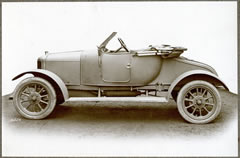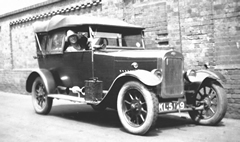During the early part of the 20th century, Frank and Alwyn Smith, cousins living in Thrapston Northamptonshire, design and manfactured a variable belt pulley. This pulley, targetted towards the early belt motorcycles and was called an iinclined pulley, later called ‘clined’ and finally concluded as ‘Clyno’. The marque was born.
 In 1909 the Clyno Engineering Company was founded and exhibited the motorcycles at the Stanley Show, a single cylinder 3HP machine then a 5/6HP V twin all powered by Stevens engines and using Chater-Lea cycle parts. Both motorcycles were fitted with the patented Clyno variable speed pulley, and Clyno telescopic legs, an elaborate stand arrangement designed to ease wheel changing and repairs.
In 1909 the Clyno Engineering Company was founded and exhibited the motorcycles at the Stanley Show, a single cylinder 3HP machine then a 5/6HP V twin all powered by Stevens engines and using Chater-Lea cycle parts. Both motorcycles were fitted with the patented Clyno variable speed pulley, and Clyno telescopic legs, an elaborate stand arrangement designed to ease wheel changing and repairs.
In 1910 the Company moved into new premises in Pelham Street, Wolverhampton. Clyno went on to develop their own motorcycle engines notably a V twin 5/6HP motorcycle and a pioneering unit construction 2 stroke lightweight. The war years came and the 5/6HP that proved to be very succesful and supplied to the Motor Machine Gun Corp as the Clyno-Vickers machine gun outfiit and also a variant for munitions transport. In 1916 Ailwyn and Frank parted company, and Frank continued as the sole proprietor.
During the war years the company also built and supplied v-twin motorcycles to Russia and in the late stages of the war, was contracted to build ABC Dragonfly aero-radial engines for the War Ministry. In 1918, Clyno engaged the services of a Mr. Charles M. van Eugene (later to join Lea-Francis) and embarked on a car design.Although this 10 HP OHV lightcar never hit production, it marked the sign of things to come.
The post war production saw the introduction of an all sprung frame 8HP V-twin motorcycle combination. This new model, and the lightweight, did not see them through the post war slump and the Clyno Engineering Company was reformed as the Clyno Engineering Company (1922). Frank Smiths father, William Smith joined the newly formed company as chairman, with Frank as managing director.
The first production cars were introduced in 1923. These were 10.8HP lightweight models using the Coventry Climax Model F engines, which were rebadged at the works by fitting a valve cover embossed with the Clyno name instead of the Climax name.
The cars were well received and a great success establishing the Clyno car brand. Morris proved to be a competitor and the two companies pitched against each other for the duration of the Clyno existence. Subsequent models were produced – 11HP, 12/28HP, 13HP, 12/35HP powered cars, produced in a wide range of body types ranging from 2 seater tourers to plush saloons.
 The company rose to be the third biggest car manufacturer in the UK, and expand into new works at Bushbury in 1927. However the depression era brought on hard times to the company. In an attempt to try and capture the low price entry market Clyno produced the 9HP Century model. This fabric bodied car did not favour well with customers and was outshone by Austin and Morris products. The Clyno Century as it was called, marked the end of the Clyno marque, with the receivers being brought in at the end of 1929.
The company rose to be the third biggest car manufacturer in the UK, and expand into new works at Bushbury in 1927. However the depression era brought on hard times to the company. In an attempt to try and capture the low price entry market Clyno produced the 9HP Century model. This fabric bodied car did not favour well with customers and was outshone by Austin and Morris products. The Clyno Century as it was called, marked the end of the Clyno marque, with the receivers being brought in at the end of 1929.
Today out of the many thousands that were originally built, the surviving Clyno vehicles live on through Clyno enthusiasts and The Clyno Owners Club and Register.






